Minua, son of Išpuini
Minua is the son of Išpuini and the grandson of Sarduri I. Unlike his predecessors, he is not mentioned in any Assyrian but only in Urartian sources. The inscriptions describing his deeds fall into three groups: the first comprises texts concerning deeds that Minua carried out together with his father Išpuini (A 3 and B 3; for these sources see the entry about Išpuini), the second comprises inscriptions informing us about the deeds of Išpuini, Minua, and Minua's son Inušpua (A 4 and B 4), while the texts in the third group refer to the accomplishments of Minua alone (A 5 and B 5).
The stone inscriptions of the third group stem from many different places, many of which were located in the vicinity of Lake Van, while others were set up in remote regions.
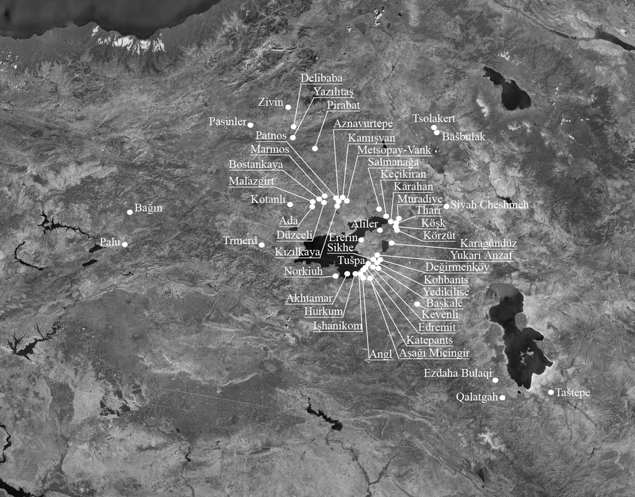
Map showing the distribution of the stone inscriptions of Minua, in: Mirjo Salvini, CTU I: 182.
The locations of the inscriptions thus reflect the approximate breadth of the Urartian territory, which underwent a large expansion during Minua's reign. It expanded as far as the Euphrates in the West and to the Araxes river in the North. In the South-East the Urartians pushed further into the territory controlled by the Mannians and, in the South, the first encounters with the Assyrians took place. As with the inscriptions of Išpuini and Minua (A 3-4 and A 3-11), many of Minua's inscriptions are protected by curse formulae.
Royal titles
I am Minua, son of [Iš]puini, strong king, [great king, king of the Bia lands, lord] of the city Ṭušpa (A 5-2 line 6).
Military campaigns
Most of Minua's inscriptions are not dated. Unfortunately, other dating criteria are also largely missing. The chronological order of his campaigns therefore remains largely unclear. The only exception is a historical text inscribed on the inner walls of a temple of Anzavurtepe (or, respectively, Aznavurtepe) near Patnos, which states that the campaigns it describes occurred in the first year after Minua's accession to the throne (A 5-11).
One campaign led Minua to the land of Buštu, to the south of Paršua, in the region of modern Iran. His second military offensive led him west to the land of Alzi, which was located at the Murat Su river (Arsanias in Ancient Greek and Latin texts) and is also known from Hittite and Assyrian sources. After the successful completion of both campaigns, Minua evidently decided to set up an inscription commemorating these deeds and acknowledging the god Haldi for achieving them. The inscription is located at the castle Anzavurtepe, which was situated at an important junction between the Euphrates and the Murat Su.
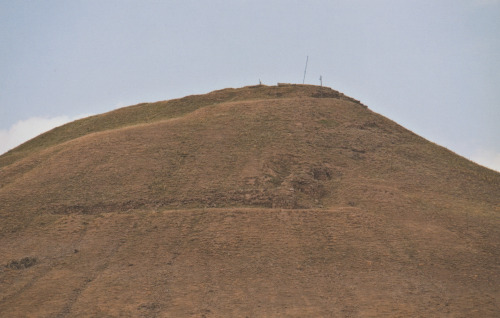
Aznavurtepe, in: Kemalettin Köroğlu and Erkan Konyar (eds.), Urartu: Doğu'da Değişim / Transformation in the East, İstanbul 2011: 31.
In the following years, Minua undertook further campaigns to the west, into the Euphrates-Murat region. Thus, an inscription in a rock niche located in Palu (Urartian Šebeteria) at the Murat Su informs us that Minua conquered the land Ṣupa beyond the Euphrates (the Urartian equivalent of the later province of Sophene in the Roman empire) and made the king of Malatya (Urartian Meliṭia), the ruler of an important Neo-Hittite state, a tributary (A 05-5). This region was the point of departure for further expeditions in the west. Among them was a campaign which led Minua into the region of the Batman Su, a tributary of the Tigris, where the land Šubria, which is also mentioned in Assyrian sources, may have been situated.
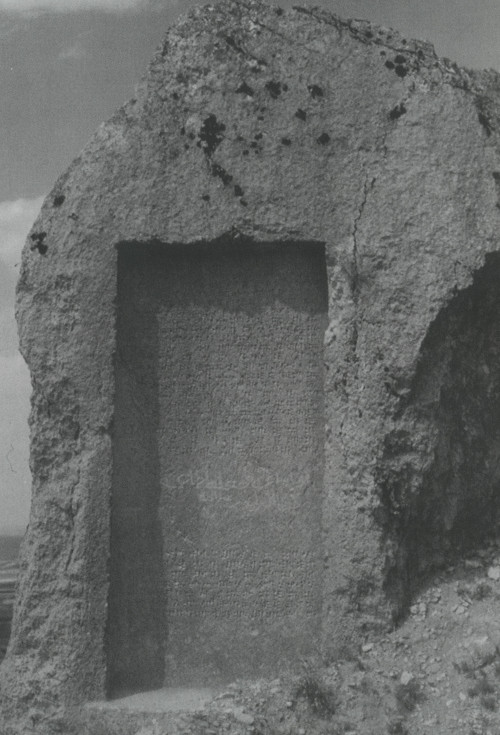
Rock inscription (Palu), in: Mirjo Salvini, CTU III: 119.
A further campaign into the Mannian territory to the east is mentioned in a rock inscription from Taštepe, south of Lake Urmia (A 5-10). It is likely that this expedition was a follow-up to the campaign to the land Buštu in Minua's first year, mentioned in the Anzavurtepe inscription (A 5-11). The fact that Minua's successor, Argišti I, also undertook several campaigns into Mannian territory shows that the expeditions did not result in the lasting control of the region, but were merely raids.
In a fragmentary annalistic account engraved on a stele from the Armenian church Surb Poģos and Surb Petros in the old town of Van (A 5-9), where it has been reused as an Armenian cross-stone (hačkar), Minua reported that during his campaigns to the upper course of the river Tigris he pushed forward to the land Aššur and conquered settlements that, until then, had been under Assyrian control. This region was the most southern zone ever reached by the Urartians.
Aside from the campaigns to the east, south, and west, Minua also undertook successful expeditions to the Transcaucasian region in the north. Thus, a rock inscription of Tsolakert/Taşburun (A 5-1) and an inscription engraved on a number of stone blocks found at the fortress of Körzüt and the surrounding settlements in the valley of the Bendimahi Çay (A 5-2) report the conquest of the territory of the Erikua. Minua reports that he conquered its capital Luḫiu, which had never been besieged before, and put the land of the Etiuḫi which had already been conquered during a joint campaign by Išpuini and Minua (A 3-4), under tribute.
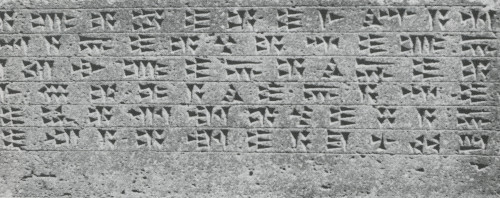
Stone block with inscription (A 5-2A) from Körzüt, in: Mirjo Salvini, CTU III: 108.
Text A 5-2 mentions a huge number of captives who were deported to the far-off cities of Ṭušpa, Aelia, and 'Alṭuquia. Minua evidently copied the Assyrian strategy of relocating the people of captured territories to far-off regions, with the aim of cutting off any existing ties. Besides the Erikua and Etiuhi, Minua also conquered the land of the Diauehi, which was likely the same as the land of Daiaeni mentioned in inscriptions of the Assyrian king Shalmaneser III. Since Minua's successor, Argišti I, also fought against this people, it is likely that Minua's campaign should be dated to the final years of his reign. An account of this endeavour is given in a rock inscription at Yazılıtaş, near Horasan, in the district of modern Erzurum (A 5-3).
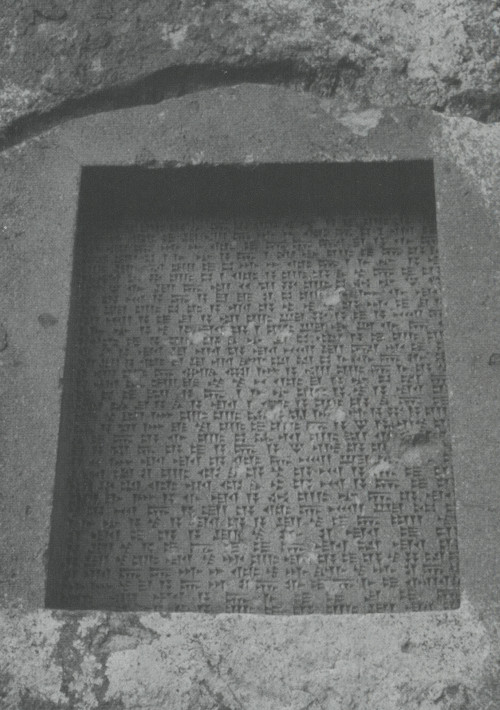
Rock inscription (Yazılıtaş), in: Mirjo Salvini, CTU III: 117.
Building activities
Minua's inscriptions inform us about several building projects. The most important was certainly the construction of a huge canal leading from a source situated approximately 55 km southeast of Van to the Urartian capital Ṭušpa. This canal is still in use today (A 5-12; A 5-13; A 5-14; A 5-15; A 5-16). According to A 5-20, it additionally serviced the "Valley of Minua" and a city whose name is only partly preserved (Uliš[x]ini). According to A 5-20 the canal also served the city of Menizaia (see also the canal of the city of Alia (A 5-17) and the canal mentioned in A 5-22; it is likely that the "Canal of Minua" is meant in both cases).
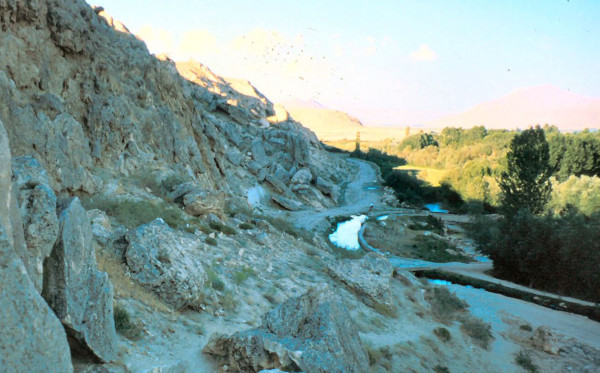
The canal of Minua, photo: Stephan Kroll.
A 5-23 mentions the construction of canals for the cities of Aiduni and Uišini. The phrase "around the city of Uišini in every place I dug a canal" points to the construction of an irrigation system related to the agricultural areas of the city of Uišini. A canal also serviced the new foundation of Minuaḫinili (A 5-24; A 5-25; area of Mount Arat) and probably also the city of Minuahinadi (A 5-24). In the city of Luḫiuni, Minua constructed a "Gate of the god Ḫaldi" and a fortress (A 5-27).
Agricultural infrastructure
In many of his inscriptions, Minua reports the establishment of agricultural infrastructure. Regularly mentioned are fields of grain, orchards, vineyards, and a building called burganani, which was probably a stable or pen where sacrificial animals were kept. Work on the agricultural infrastructure is attested in the areas of the cities Arṣuniuini (A 5-28; A 5-30; A 5-31) and Qutume (A 5-11). A 5-33 refers to an orchard and a "vineyard of Minua" in the vicinity of modern Güsak, while A 5-59 reports the construction of a fountain. The inscription A 5-66, which is inscribed on a rock niche at the north-west slope of Van Kalesi at a distance of 20 m from Sardur's castle, refers to a silo (ʾari-building) which Minua claims to have filled. The commodity he filled it with is not mentioned explicitly, but the unit of measurement kapi indicates that Minua was referring to grain. Filling such ʾari-buildings was also mentioned in inscriptions of kings Argišti I, Sarduri II, and Rusa, son of Erimena. According to Argišti I and Sarduri II's inscriptions, an ʾari-building could be part of a barzidibduni-building, which probably had a cultic function (A 9-19), or it could be related to an ašiuši-building, which was presumably a banquet hall (A 8-30 and A 9-20). Although Minua's rock inscription and its later counterparts clearly refer to a nearby store room, a corresponding building structure has not yet been detected.
The vineyard of Minua's wife Tariria
Most notable among the Urartian written sources is the inscription A 5A-1, whose provenance remains unclear. It refers to a vineyard which belonged to, or had been dedicated to, Minua's wife, Tariria. The vineyard was called "Creation of Tariria", or, respectively, "the Taririan one."
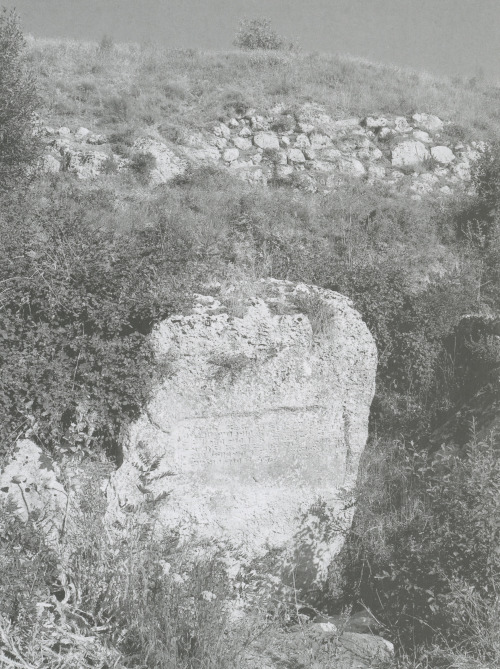
The inscription of Tariria, the wife of Minua, in: Mirjo Salvini, Das Corpus der urartäischen Inschriften, in: Stephan Kroll et al. (2012), Biainili-Urartu, The Proceedings of the Symposium Held in Munich 12.-14. October 2007 (Acta Iranica 51), Leuven 2012: 123.
Fortresses
Minua mentioned that he constructed several fortresses. They were located in the cities Aludiri (A 5-37), Arṣuniuini (A 5-28; A 5-30; A 5-31), Mešta (A 5-10) and Quṭume (A 5-11; both in the western/southwestern area of Lake Urmia) as well as in Minuahinili (A 5-25; A 5-26), Luhiuni (A 5-27); a city whose Urartian name is not mentioned (A 5-29, modern Karahan) A 5-33 and 36 (modern Güsak); A 5-34 (Kevenli); A 5-35 (Körzüt); A 5-38 and 39 (Aznavurtepe/Patnos), A 5-40A (Pirabat), A 5-41 (Delibaba), A 5-43 (Yukarı Anzaf), A 5-47 (Sarmaç), A 5-51 (Malazgirt), A 5-52 (Başkale) and A 5-67 (Bostankaya).
A 5-29 presents us with a short enumeration of what constitutes a sound fortress, i.e. a burganani-building, an orchard, and a vineyard, while A 5-34 mentions a ṭulurini-building as part of a fortress. A 5-33 gives the fortress's name as "Fortress of the god Haldi".
An ašihuši-building is attested in A 5-65A (provenience unknown), barzudibiduni-buildings of Minua are attested in A 5-60 (Sarmaç), A 5-61 (Siyah Cheshmesh), A 5-62 (Yukarı Anzaf), A 5-63 (Yedikilise), A 5-64 (Değirmenköy) and an iriduduni-building of Minua is mentioned in A 5-78 (Düzceli).
For the ʾari- and burganani-buildings see section "Agricultural infrastructure".
Religious buildings
Minua also claims the construction of several temples and other religious buildings such as tower temples (susi), chapels (iarani), cult stelae(?) (ṭiribišuzi), and gates for certain deities. He further mentions the erection of several stelae for the god Haldi and other Urartian deities.
Religious activities
According to A 5-33, Minua established a state cult ritual connected with the harvest. For the great number of religious buildings Minua constructed see the above section "Religious Buildings."
Inscriptions on metal objects (B 5-1 to 10)
Bronze objects were found in Karmir Blur (B 5-1 to 5), Yakarı Anzaf (B 5-6 to 7), Burmageçit/Tunceli (B 5-8) and Aznarvurtepe (B 5-9). The origins of B 5-10 are unknown. The Urartian inscriptions mainly refer to Minua's ownership of the item, while B 5-9 (on a candelabra) refers to a votive offering to the god Haldi. The objects are classified as an arrow head (B 5-6), a bracer (B 5-1), cups (B 5-5), a helmet (B 5-8), a pad (B 5-4), a pectoral (B 5-2), and a tag (B 5-7 and 10).

Bronze cup from Karmir-blur, in: Mirjo Salvini, CTU IV: 30.
Minua's horse Arṣibini and its jumping record
A 5-91 gives an account of an athletic performance: Minua claimed that his horse Arṣibini covered a distance of 22 cubits in a single jump. Among the ancient Near Eastern written sources, this text is remarkable in two respects: firstly, it is extraordinary that a sporting achievement was recorded in an inscription. The only other example among the Urartian written sources is an inscription of Argišti, son of Rusa, which reported that Argišti shot an arrow a distance of 950 cubits. Secondly, it is unusual for a text to include the name of an animal which was not associated with a deity. The great significance of horses in Urartu is further reflected by their visual representations on a variety of objects, such as reliefs and pectorals.
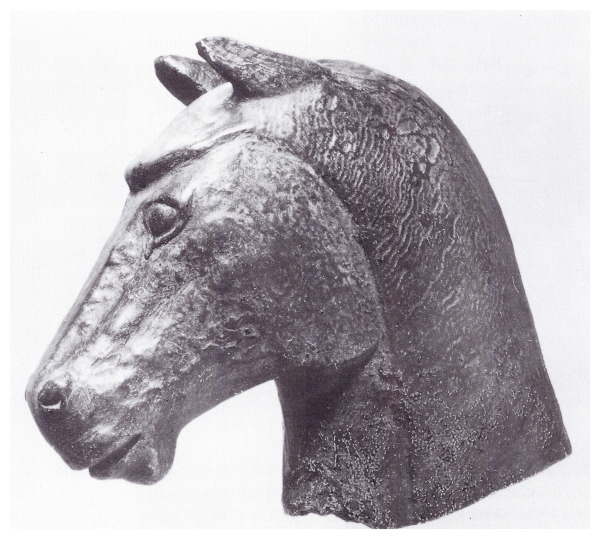
Bronze head of a horse from Karmir-blur, History Museum of Armenia, in: Ralf-Bernhard Wartke (1993), Urartu. Das Reich am Ararat, Mainz: 39.
Further reading
Birgit Christiansen
Birgit Christiansen, 'Minua, son of Išpuini', Electronic Corpus of Urartian Texts (eCUT) Project, The eCUT Project, a sub-project of MOCCI, 2020 [http://oracc.museum.upenn.edu/ecut/urartianrulersandtheirinscriptions/minuasonofipuinia5andb5/]